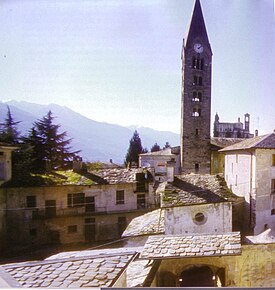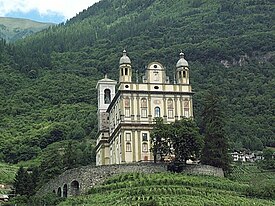Tresivio
| Tresivio | ||
|---|---|---|

|
|
|
| Country | Italy | |
| region | Lombardy | |
| province | Sondrio (SO) | |
| Local name | Tresive | |
| Coordinates | 46 ° 10 ' N , 9 ° 57' E | |
| height | 520 m slm | |
| surface | 15.9 km² | |
| Residents | 2,016 (Dec. 31, 2019) | |
| Population density | 127 inhabitants / km² | |
| Post Code | 23020 | |
| prefix | 0342 | |
| ISTAT number | 014070 | |
| Popular name | Tresiviaschi or Tresiviesi | |
| Patron saint | Peter and Paul ( June 29 ) | |
| Website | Tresivio | |
Tresivio is a northern Italian municipality ( comune ) with 2016 inhabitants (as of December 31, 2019) in the province of Sondrio in Lombardy .
geography
The municipality is located about six kilometers east-northeast of Sondrio north of the Adda in the Veltlin Valley. The neighboring municipalities are Montagna in Valtellina , Piateda , Poggiridenti and Ponte in Valtellina . It is crossed by two streams: the Rhon, which forms the border between Tresivio and Ponte, and the Rogna, bordered by the Tresivio and Poggiridenti, both tributaries of the Adda. Tresivio is a very agricultural country, very rich in vineyards (characteristic of the Santa Casa di Loreto) and apple orchards. Above the town center, a road leads up the slope and through the vineyards to the hamlets of Piedo, Sant'Abbondio, the district of Masotti and the last Sant'Antonio. The commune has a rather simple but characteristic orographic configuration: it rises from the valley floor and rises with two morphologically interesting structures such as the Rupe del Calvario and the Conoide della Fiorenza (an ancient buried city in the Middle Ages).
Toponomics
The name Tresivio probably comes from the Latin Tres Viae , three streets, because of the original city center, where the three main streets from which the modern city developed.
history
The Bishop of Como , who owned important properties in the area, lived in the Episcopal Palace of Tresivio for three months a year. During the rule of the Visconti and the Sforza (1325-1500), Tresivio became the capital of the Valtellina : it was the seat of the Supreme Court of the valley and the ducal governor had to go to Tresivio to administer correct justice. Directly on the rock of Golgotha, called Motta , stood the palace of the Marquis Malaspina, general captain of the valley on behalf of the Visconti, the parish church, the churches of San Michele and San Giovanni Battista, the bishop's palace and finally the castle. The oldest trace of the castle dates back to 1046: like the other Pieve, it belonged to the Bishop of Como. The lands that belonged to the castle were held at the expense of all those who were defended and commonly called Castra .
The wars between the Guelfs and Ghibellines ruined Tresivio: in 1437 it was practically destroyed by the local gentleman belonging to the Guelfs faction, Antonio Beccaria, during the hard fight against Stefano di Pendolasco. In 1487, on the occasion of the second invasion of Graubünden, the castle was plundered and finally destroyed in 1513. Today there are still some remains of the imposing mansion, on the top of the hill is the seventeenth century Church of San Michele. In the Middle Ages, the area of Tresivio was commonly called Tresivio Piano , which corresponds to the current territory of the municipality of Piateda , and Tresivio Monte, which, in addition to Tresivio and Acqua, included Paiosa and Boffetto. On August 30, 1427, the Tresivio Piano and Tresivio Monte separated. On November 5, 1473, the mountain part of Tresivio formed a new independent body called Monte dell'Acqua, or simply Acqua .
With the beginning of the rule of the Canton of Graubünden (1512), Tresivio lost its important role as the capital in favor of Sondrio, in a more favorable place for transport, communication, the passage of goods, the expansion of the Valtellina economy and, last but not least, the physical one Expansion of the city. However, Tresivio remained the seat of the Vicar of Valle, who served as judge, until around 1540. In 1600 the country was involved in the first person in the difficult years of the Valtellina Wars, which began with the revolt against Graubünden on July 19 [1620].
The wars were accompanied by famines and epidemics including the plague of 1630. After a vote, the Valtellina parishes chose Tresivio to build a Marian shrine: on November 30, 1646 the foundation stone was laid for today's Holy House, which later became the symbol of the parish and the devotion of the entire Valtellina to the Virgin Mary.
traffic
The Strada Statale 38 on the Stelvio limits the municipality to the south. The common train station is in the neighboring municipality of Poggiridenti .
Attractions
Sacred buildings
- Parish church of Santi Pietro e Paolo, Piazza SS Pietro e Paolo, Tresivio Centro, in the apse preserves the painting Assunta by the painter Michele Annoni (1774).
- Church of San Giovanni, Piazza SS Santi Pietro e Paolo, Tresivio Centro
- Church del Calvario, via Calvario, Tresivio Centro (on Rupe del Calvario)
- Church of San Tomaso, Quartier San Tomaso, preserves the fresco Madonna and Child and Saints Rocco and Sebastiano by the painter Giovannino da Sondalo (14th century).
- San Rocco church, Piedo district.
- Sant'Abbondio Church, Sant'Abbondio district.
- Church of Santo Stefano in the district of Santo Stefano.
- The pilgrimage church of Nostra Signora di Loreto ( dedicated to the Birth of Mary), built in 1646.
Personalities
- Beccaria family
- Giovanni Beccaria (* around 1400 in Tresivio; † around 1455 in Rogna?), Left Tresivio, the previous residence of the family, in 1430 because of frequent raids by the Guelph and Ghibelline parties and built a permanent castle near Rogna.
- Antonio Beccaria (* around 1420 in?; † around 1475 in Masegra?), Son of Giovanni, was raised to the knighthood and acquired the Masegra Castle above Sondrio through marriage along with all the goods of the noble family De Capitanei. He was a head of the Guelphs, fell out of favor with the then sovereign Duke Philipp Maria of Milan and, despite the 1447 war between Milan and Venice, helped defend the valley until help from Milan came.
- Ferrando Beccaria (* around 1550 in Sondrio; † after 1593 ibid), he sold the castles of Beccaria to Masegra and their tithes and many goods to the von Salis family in 1593.
literature
- Anna Ferrari-Bravo, Paola Colombini: Guida d'Italia. Lombardia (esclusa Milano). Milano 1987, p. 381.
- Lombardia - Touring club italiano, Touring Editore (1999), ISBN 88-365-1325-5 , Tresivio Online
Web links
- Tresivio (Italian) on tuttitalia.it/lombardia
- Acqua (Tresivio) (Italian) on lombardiabeniculturali.it/luoghi/
- Tresivio (Italian) on lombardia.indettaglio.it/ita/comuni/so/
Individual evidence
- ↑ Statistiche demografiche ISTAT. Monthly population statistics of the Istituto Nazionale di Statistica , as of December 31 of 2019.
- ↑ Guido Scaramellini: Beccaria. In: Historical Lexicon of Switzerland . 2002 .
- ↑ Giovanni Beccaria at biblio.unibe.ch/digibern/hist_bibliog_lexikon_schweiz (accessed on June 7, 2017).
- ↑ Antonio Beccaria at biblio.unibe.ch/digibern/hist_bibliog_lexikon_schweiz (accessed on June 7, 2017).
- ↑ Ferrando Beccaria at biblio.unibe.ch/digibern/hist_bibliog_lexikon_schweiz (accessed on June 7, 2017).




